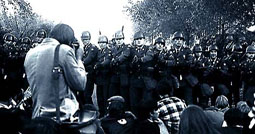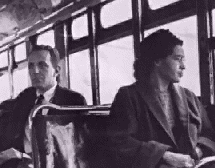|
● Why
Did the Social Movements Begin?
● Who
Worked in the Social Movements?
● What
Is a Social Movement?
● The
Civil Rights Movement
● Organizations
● Direct Action Tactics
● Changes
● The Youth Movement
/Anti-War Movement
● The Women's Movement
● Conclusion
The Women's Movement
 |
|
Media Covering
Anti-war Protest
|
 The
women's movement in the 1960s was started by three groups of women
and an accident. The first was a group of professional women who
were appointed to a Commission on the Status of Women by President
Kennedy in 1961. Most were not feminists until they began to investigate
the situation for women in the United States. They found that women
in the U. S. were not equal with men, and the situation of some
women was shocking. So they recommended that Commissions be established
in all 50 states, and the number of women working on Commissions
soon grew to over 1000. The
women's movement in the 1960s was started by three groups of women
and an accident. The first was a group of professional women who
were appointed to a Commission on the Status of Women by President
Kennedy in 1961. Most were not feminists until they began to investigate
the situation for women in the United States. They found that women
in the U. S. were not equal with men, and the situation of some
women was shocking. So they recommended that Commissions be established
in all 50 states, and the number of women working on Commissions
soon grew to over 1000.
 The
second group were mostly white housewives and mothers who read Betty
Friedan's book, The Feminine Mystique,
published in 1963. The book changed the way large numbers of women—between
10000 and 20000—thought about themselves and other women. The
second group were mostly white housewives and mothers who read Betty
Friedan's book, The Feminine Mystique,
published in 1963. The book changed the way large numbers of women—between
10000 and 20000—thought about themselves and other women.
 The
third group were young activists in the civil rights and anti-war
movements. They believed the male leaders of these movements were
discriminating against women in the movement. They
became known as the "women's liberation" group, or "women's
lib", used radical tactics and received a great deal of bad
publicity. This group found strong support among large
numbers of young activists from other organizations. The
third group were young activists in the civil rights and anti-war
movements. They believed the male leaders of these movements were
discriminating against women in the movement. They
became known as the "women's liberation" group, or "women's
lib", used radical tactics and received a great deal of bad
publicity. This group found strong support among large
numbers of young activists from other organizations.
 The
accident was a word in the Civil Rights Act passed in 1964. The
law made discrimination in employment based on race or sex illegal,
adding women to those groups not to be discriminated against. The
accident was a word in the Civil Rights Act passed in 1964. The
law made discrimination in employment based on race or sex illegal,
adding women to those groups not to be discriminated against.
 |
| Mrs. Rosa
Parks |
 From
these three groups and the almost accidental word, began the women's
movement. There was, of course, a long history of women working
for equal rights before this, just as there had been a long history
of Afro-American effort for equal rights. In 1966, the National Organization for Women (NOW) was formed by the first
two groups. Many radical, active feminists joined as the movement
grew stronger. Many of the radicals were young women, both black
and white, who had worked in the civil rights movement and were
critical of the leadership for discriminating against women. Women
were strong leaders and organizers, they said, but the men only
allowed them to cook and do secretarial
work. From
these three groups and the almost accidental word, began the women's
movement. There was, of course, a long history of women working
for equal rights before this, just as there had been a long history
of Afro-American effort for equal rights. In 1966, the National Organization for Women (NOW) was formed by the first
two groups. Many radical, active feminists joined as the movement
grew stronger. Many of the radicals were young women, both black
and white, who had worked in the civil rights movement and were
critical of the leadership for discriminating against women. Women
were strong leaders and organizers, they said, but the men only
allowed them to cook and do secretarial
work.
 The
changes women worked for included changes in economic practices,
such as not only asking equal pay for equal work, but also equal
opportunity for jobs in fields such as science and technology, management
and politics. Women also wanted changes in social practices and
attitudes which would acknowledge that women were not inferior to
men in intelligence or ability. The
changes women worked for included changes in economic practices,
such as not only asking equal pay for equal work, but also equal
opportunity for jobs in fields such as science and technology, management
and politics. Women also wanted changes in social practices and
attitudes which would acknowledge that women were not inferior to
men in intelligence or ability.
 To
educate the public and gain support for their objectives, women
used many of the same tactics used by the civil rights and anti-war
movements and added some of their own tactics. The
newspapers and TV made the women in the movement seem to be men-hating
women who did not want to be feminine.
Women worked hard in the 1970s to change this image. To
educate the public and gain support for their objectives, women
used many of the same tactics used by the civil rights and anti-war
movements and added some of their own tactics. The
newspapers and TV made the women in the movement seem to be men-hating
women who did not want to be feminine.
Women worked hard in the 1970s to change this image.
Previous Page Next
Page
|

